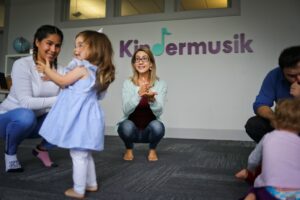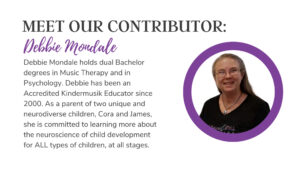For the Love of Bunnies and Benefits
Does your toddler have a snuggly bunny they LOVE? Then they will LOVE playing this game with their furry friend. For such a little children’s rhyme, there is a lot of learning happening with your expressive interactions and repeated play.
View this post on Instagram
Expand on their Interest
When your child has a strong interest in something, it offers an exceptional opportunity to expand so many areas of their childhood development. Positive emotions attached to learning opportunities result is a longer attention span, interest in repetition, and stronger neural connections for more well-rounded learning. With new and unique ways
to play with their favorite objects, their interest in it will last longer and they become curious to learn more. “What else can I do with this?” This question itself has lifelong benefits for their curiosity and knowledge building.
Language Development
Simply hearing the cadence of rhyme is immersing your child in learning the format and concepts of speech, even in the earliest stages of your baby’s language development. Toddler’s brains are avidly seeking the connection between words and actions, helping with both their receptive language (understanding what others say), and their expressive language (ability to communicate using their own words).
Focused Attention / Observation
When the rhyme says “I see..”, we are reinforcing our child’s observational skills, increase their attention span as they keep looking at an object to find and describe the many things they see with their eyes.
Sign Language
 Even when your child can hear perfectly well, using sign language in coordination with speech has cognitive benefits. When a child can SEE and HEAR the word at the same, they are learning two ways to express the same concept, which builds stronger neural connections leading to easier language development AND, there are times you and
Even when your child can hear perfectly well, using sign language in coordination with speech has cognitive benefits. When a child can SEE and HEAR the word at the same, they are learning two ways to express the same concept, which builds stronger neural connections leading to easier language development AND, there are times you and
your child may want to communicate silently. Using the sign for SEE can be used when you discover a real animal outside and don’t want to scare them, when you are in a quiet place and need to communicate, and so many more life circumstances. Along with the silent mouthing of “Yay” at the end, the wiggling hands in the air is sign language for celebrating. It is also how people who are deaf applaud each other for accomplishments. Having a quiet visual way to celebrate appreciation of your child’s actions can also come in very handy.
Emotional Awareness
“Surprise!” is such a fun facial expression to imitate. AND… It is a fabulous word to use when your child is startled instead of the word “scared”. “Oh, I didn’t mean to surprise you.” may help your child have a more positive reaction, and recover more quickly. As we play around with the facial expressions for sad and happy at the end, two year
olds and preschoolers are learning to read facial expressions and recognize the emotions they are associate with… an amazing start in developing their emotional intelligence.
Turn-Taking prepares for school readiness
At first, you will be chanting the rhyme and moving the bunny. Your child “turn” will likely be to request it again and again. Once the rhyme is familiar, your child may move the bunny while you chant the rhyme. Little step toward letting them take on more of the experience can be leaving off some of the repeated words at the end, and let them say the repeated quiet words. As you continue to leave off more of the ending words their memory for the rhyme is building until they can complete it all themselves. Maybe while you are moving the bunny???
Memorization leads to better reading skills
“Experts in literacy and child development have discovered that if children know eight nursery rhymes by heart by the time they’re four years old, they’re usually among the best readers by the time they’re eight. “- Mem Fox, Reading Magic
Motor Skill Development and Inhibitory Control
As your child moves the bunny along with the rhyme, they are by creating the correct movements in connection with the action words they hear. They are practicing, in a delightful way, when to move and stop, and moving faster and slower. As we highlight how proud they are of this control over their gross motor skills, it will build their desire to
have this control in other situations.
By using two FINGERS outward from a fist, your “hand” bunny can move along with this rhyme and help develop their fine motor skills as well. This can be a great game to play while waiting in line at the grocery store, or in a doctors office. No props needed.
Musical awareness
Last, but not least, this rhyme introduces opposing concepts in a perfect way to develop early childhood development in cognition and music, at first in awareness and progressing toward active skills:
Loud and quiet are introduced by the repeated sounds, with the first three louder and followed by more with a quiet voice.
Crescendo (getting louder) and Decrescendo (getting louder) as well as melodic direction (the pitcho going up and down are introduced with the “bloops” as the bunny hops away (starting loud with a higher pitch) and hops back (starting with a quiet and lower pitch).
Ready for more?
 Now that your child is ready to expand connections to their favorite bunny friend, you can continue to add more. Download the free Kindermusik APP on any mobile device, and enjoy these songs. Once in, click on the MUSIC tab at the bottom, tap on SONGS at the top, and search for RABBIT. “I Saw a Little Rabbit” and “Usagi, Usagi”
Now that your child is ready to expand connections to their favorite bunny friend, you can continue to add more. Download the free Kindermusik APP on any mobile device, and enjoy these songs. Once in, click on the MUSIC tab at the bottom, tap on SONGS at the top, and search for RABBIT. “I Saw a Little Rabbit” and “Usagi, Usagi”
When you and your child participate in our Kindermusik classes with our accredited educators at Grow and Sing Studios, we’d love to hear what your child’s interests are so we can provides songs and activities to expand the things that bring them joy. We have so many resources to make it a little easier for you to connect with your child and
provide life-long benefits in their development. A big bonus when you enroll is accessing a much larger selection of music, books, and more on the Kindermusik App.
Sign up to Preview a Class with us today and see the magic in action.
If you have some favorite rhymes, songs or stories about bunny rabbits you would
recommend to other parents, please share in the comments!
